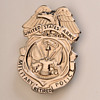Posted 10 years ago
gforce1108
(12 items)
Another craigslist find, restoration project. Very nice inlay table - was pretty beat up when we got it. Cleaned up very nicely with acetone. Stained it and finished with gloss urethane. Can only imagine the work involved in building this table!
Pictures uploaded here are "after", "before", inlay details, carving details
Many more pictures here: http://s292.photobucket.com/user/gforce1108/library/Inlay%20table
Now it's time to sell off some of the pieces I didn't restore so there is enough room for the other projects!




















You seem to be a big fan of acetone. While it won't normally bother most wood it will have a bad effect on some inlays. Even after you finish the piece it can come back and bite you in the butt with inlays. The acetone can unseat the inlay and it will pop.
Thanks for the acetone info. I try to limit the amount of exposure to delicate wood by dipping a toothbrush in it and cleaning a small area then immediately wiping it dry. I've had problems with stripers leaving residue behind. This is my first restoration of a piece with inlay though... What do you suggest that would be better than acetone?
If I am dealing with an older piece I use 50/50 mix of white vinegar and water to clean the surface. If that doesn't look good I test the finish with lacquer thinner. Use masking tape to make a small square center area. Put a drop or two (no more) of lacquer thinner inside the taped off area. If the finish bubbles up it isn't a penetrating sealer or finish. If it dulls and when you rub it with a paper towel and it peels like after you use a pencil eraser and need to brush stuff away then it is probably a penetrating finish. If you get similar or no effect then it is most likely a silicone finish. If the item is really old and painted use a drop of pure ammonia. The only thing that will remove real milk paint is ammonia. Although if you remove milk paint you are a dam fool.
A Game of five card stud ant one?